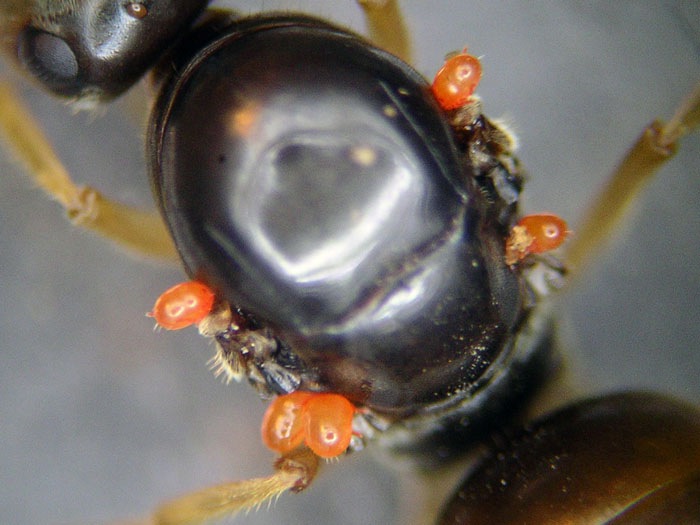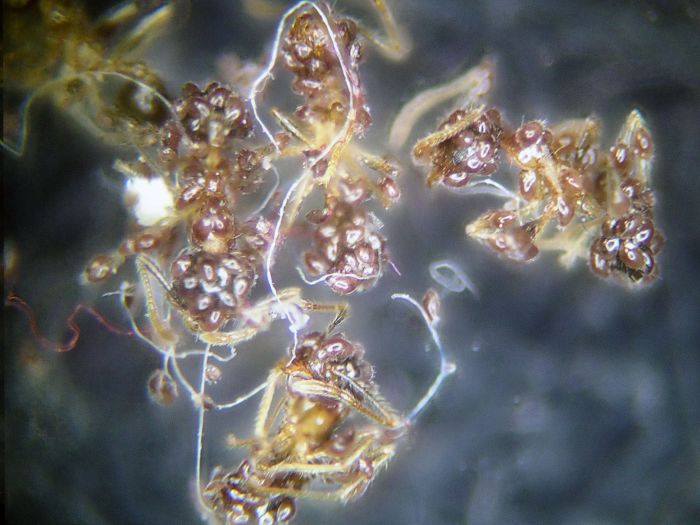hi!
I dug up a pheidole colony a while ago and they were fine, until today when i saw a mite on one of the queens I'm scared for their well being any suggestions for removal?

hi!
I dug up a pheidole colony a while ago and they were fine, until today when i saw a mite on one of the queens I'm scared for their well being any suggestions for removal?
Some mites are harmless food mites, and some mites are blood suckers! Pictures will help to ID what kind of mites they are!hi!
I dug up a pheidole colony a while ago and they were fine, until today when i saw a mite on one of the queens I'm scared for their well being any suggestions for removal?
YJK
Ant Keeping & Ethology Discord - 2000+ Members and growing
Statesideants.com - order live ants legally in the US
Wild ants have mites and have ways to deal with the mites (in their natural habitat), another reason why taking a mature colony out of the wild and putting them in captivity is not encouraged by experienced ant keepers.
If you've enjoyed using my expertise and identifications, please do not create undue ecological risk by releasing your ants. The environment which we keep our pet insects is alien and oftentimes unsanitary, so ensure that wild populations stay safe by giving your ants the best care you can manage for the rest of their lives, as we must do with any other pet.
Exotic ants are for those who think that vibrant diversity is something you need to pay money to see. It is illegal to transport live ants across state lines.
----
Black lives still matter.
well, i can't find the mite anymore, hope it is gone
I had parasitic mites on a few queens/colonies. Some were bored into the queens between the segments of their exoskeleton, and some were walking around all over the ants. The ones that were not bored in, killed the whole colony within a day. The ones bored into the queens I managed to remove, but a lot of those queens died within a week or so.


Edited by dspdrew, December 23 2016 - 7:39 AM.
Added images of the two parasitic mite infestations
nope no springtails
I just added images to my previous post showing the two definite parasitic mite infestations my ants experienced.
I just watched an AntsCanada video about how lemon slices placed in the outworld, helped clear up the mites. The research is still ongoing though, but you could try putting a slice of lemon in your outworld, and watch them. At first they avoided it, but eventually the ants put their food on it. The guess was that the citrus helped relieve the ants from the irritation of the mites, but like I said, the research is still ongoing, so if you try it, just make sure you keep an eye on your ants. ![]()
I remember mites Drew had, from the colony of Pheidole megacephala I gave him. Didn't even see any when I gave them to him (or I wouldn't have done so), and then suddenly they exploded in population out of nowhere.
The second Pheidole megacephala colony had the same issue. I was keeping them and about 3 months in, suddenly there was a huge explosion of mites all over, and I never even gave them outside food.
Third attempt at Pheidole megacephala colony. Same thing. And I was extra careful about any food with mites. About three months in (again), a huge population of mites appeared in their setup.
Even baked the dirt the second and third times, so it wasn't that.
Fourth colony of Pheidole megacephala, I found in a different part of the apartment complex and finally had no mite problems. But I put them in the freezer.
Most mites are harmless as said though, its pretty rare to actually get parasitic mites. I have grain mites in my Pogonomyrmex rugosus colony, because guess the oats we had were infested with them. They never bother the workers, and just clean up the trash. I tried cleaning them out, because there were thousands of grain mites. However, they just populated again. Kind of annoying how fast the grain mites populate, but at least they don't bother the workers. There are booklice in there too, which pretty sure I've seen them eating some of the grain mites.
Edited by Vendayn, January 1 2017 - 4:59 PM.
i saw a worker carrying a smushed mite between her mandibles, only three left, they are wandering in the outworld
I would imagine that ants in the wild have a way of keeping mite populations low otherwise like Vendayn experienced the mites would kill the ants off. It might be that the ants can recognize that they have mites and are attracted to things that will kill them like citrus fruits for example. I'm sure someday we'll figure out what ants in the wild do.
Currently Keeping:
Trachymyrmex septentrionalis
Pheidole pilifera
Forelius sp. (Monogynous, bicolored) "Midwestern Forelius"
Crematogaster cerasi
Pheidole bicarinata
Aphaenogaster rudis
Camponotus chromaiodes
Formica sp. (microgena species)
Nylanderia cf. arenivega
We should respect all forms of consciousness. The body is just a vessel, a mere hull.
Welcome to Lazy Tube - My Camponotus Journal
I'd try adding some citrus fruits, like lemons (in fact I think adding a small chamber with a citrus fruit inside is generally a good idea even if a colony doesn't have mites).
Edited by drtrmiller, January 2 2017 - 5:37 AM.
Actually I was talking about a small chamber within the setup, probably separated by at least meter of tube from the rest of the formicariums and outworlds. Basically an offer so the ants can use it when they need it (to clean stuff or themselves).
We should respect all forms of consciousness. The body is just a vessel, a mere hull.
Welcome to Lazy Tube - My Camponotus Journal
Actually I was talking about a small chamber within the setup, probably separated by at least meter of tube from the rest of the formicariums and outworlds. Basically an offer so the ants can use it when they need it (to clean stuff or themselves).
I was thinking the same thing. It'd be interesting to see someone try it and see how the ants react. My guess is that they would probably get used to it after a little while.
I can tell you in 4-8 weeks when my AntKit order has arrived and my Colony has gotten over it's semi-hibernation-diapause phase. ![]()
Though they will be just about 10-15 ants then, so I'm not sure if they will even travel far enough through the setup to find the lemon.
I'll also put the lemon into a modified box for 125 gram butter pieces so the smell stays a bit more contained, in case 1m of tubing isn't enough.
Edited by Serafine, January 2 2017 - 12:53 PM.
We should respect all forms of consciousness. The body is just a vessel, a mere hull.
Welcome to Lazy Tube - My Camponotus Journal
I'd try adding some citrus fruits, like lemons (in fact I think adding a small chamber with a citrus fruit inside is generally a good idea even if a colony doesn't have mites).
Ant Keeping & Ethology Discord - 2000+ Members and growing
Statesideants.com - order live ants legally in the US
0 members, 1 guests, 0 anonymous users